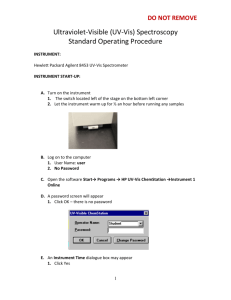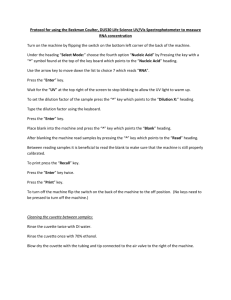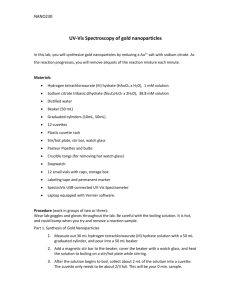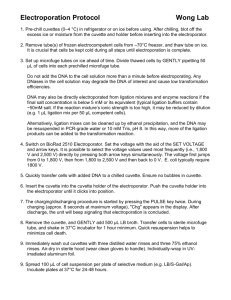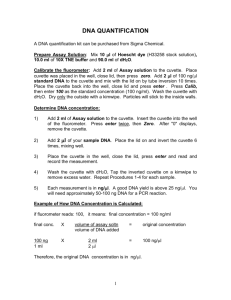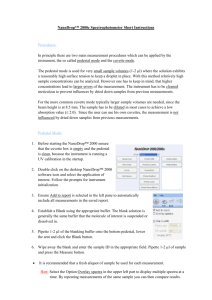Protocol for molecular weight measurement using the Zetasizer
advertisement
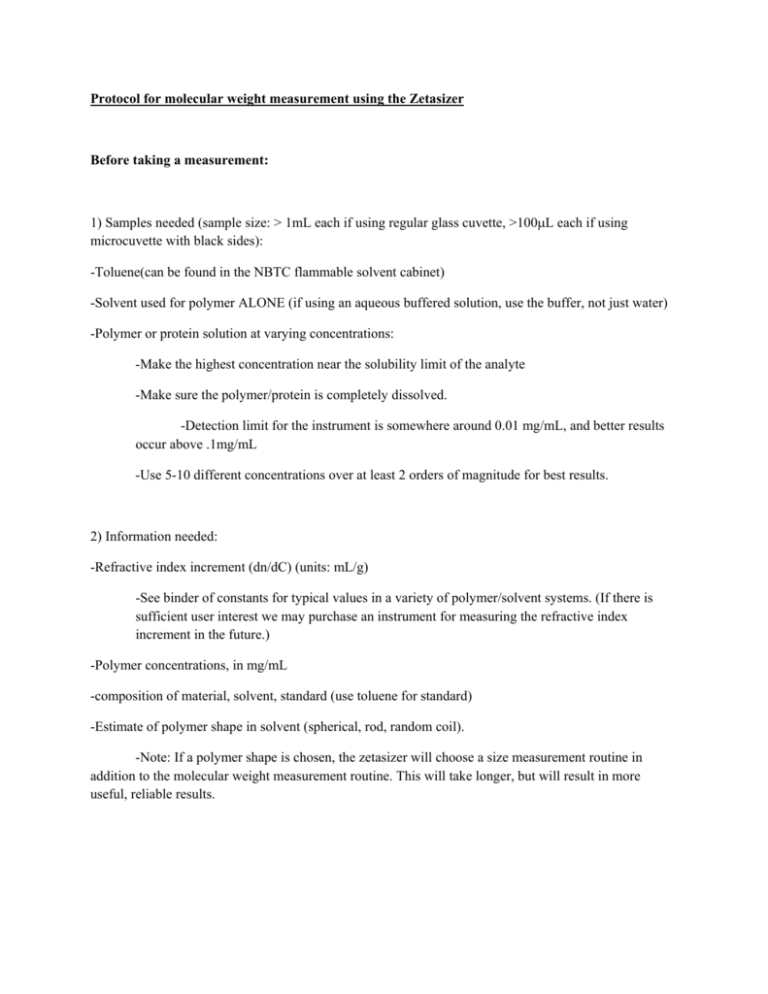
Protocol for molecular weight measurement using the Zetasizer Before taking a measurement: 1) Samples needed (sample size: > 1mL each if using regular glass cuvette, >100μL each if using microcuvette with black sides): -Toluene(can be found in the NBTC flammable solvent cabinet) -Solvent used for polymer ALONE (if using an aqueous buffered solution, use the buffer, not just water) -Polymer or protein solution at varying concentrations: -Make the highest concentration near the solubility limit of the analyte -Make sure the polymer/protein is completely dissolved. -Detection limit for the instrument is somewhere around 0.01 mg/mL, and better results occur above .1mg/mL -Use 5-10 different concentrations over at least 2 orders of magnitude for best results. 2) Information needed: -Refractive index increment (dn/dC) (units: mL/g) -See binder of constants for typical values in a variety of polymer/solvent systems. (If there is sufficient user interest we may purchase an instrument for measuring the refractive index increment in the future.) -Polymer concentrations, in mg/mL -composition of material, solvent, standard (use toluene for standard) -Estimate of polymer shape in solvent (spherical, rod, random coil). -Note: If a polymer shape is chosen, the zetasizer will choose a size measurement routine in addition to the molecular weight measurement routine. This will take longer, but will result in more useful, reliable results. Taking a Measurement: Clean the cuvette -3x rinses each in water, ethanol, and toluene, drying the cuvette after using each solvent. Fill the cuvette with toluene -For the large volume quartz cuvette, add to the height used in size measurements. For the microcuvette, add ~200μL. -Cap the cuvette (Note: The microcuvette is cracked on top; cover with parafilm. Do not put the parafilm too far down or else the cuvette will not fit in the Zetasizer holder; just ~1mm below the broken edge is fine.) Set up the instrument for a measurement as you would for a size or zeta potential measurement. Instrument instruction #1: “Press Start to begin dark measurement” -Close the lid, remove any sample cuvette in the holder, press Start. Instrument instruction #2: “Insert scattering standard cuvette and press Start when ready” -Insert cuvette with toluene. When using the microcuvette, the etched side should be sitting on the right hand side of the zetasizer. Instrument prompt: “Accept measurement of standard?” -Accept if the count baseline is reasonably level and consistent. It may take several minutes for the system to equilibrate, and therefore it may take several measurements until the baseline is reliable: OK Not OK Not OK (Note: If a temperature equilibration time has been chosen by the user, re‐running this initial measurement will Instrument instruction #3: “Insert solvent cuvette and press Start when ready” -Remove toluene from cuvette, blow out with N2 to dry. -Rinse cuvette 3 times in analyte solvent, then fill with solvent (using same volume as with toluene). -Dry cuvette, cap, and replace in sample holder. Instrument prompt: “Accept measurement of solvent?” -Accept if the count baseline is reasonably level and consistent. Instrument instruction #4: “Insert sample cuvette and press Start when ready” -Remove solvent, rinse with water or fresh solvent if desired, and blow out cuvette with N2 to dry. -The first sample can be at any concentration, but the lower-concentration samples are more likely to be noisy and throw off the overall curve. Instrument prompt: “Enter sample concentration” -Enter sample concentration, in units of mg/mL. Instrument prompt: “Accept data?” -Accept if the count baseline is reasonably level. Press “cancel” to delete this point, if it seems to be well off of its neighbors on the curve. -If you are doing size measurements, the size measurement will occur at this point and take several minutes. If not, the instrument will go directly to the next prompt: Instrument prompt: “Measure another concentration?” -If you have another sample, press yes, and the instrument will begin from the beginning of section #4, “Insert sample cuvette and press Start when ready” Repeat steps for section #4 until all the samples have been analyzed. If one datapoint is far off of the others, re-run the sample, and throw it out permanently if it still looks bad. This is more likely to occur at low concentrations, or if the cuvette is not scrupulously clean.
